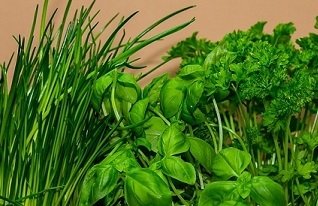Let's Dry Some Herbs
Dona Jenkins, Master Food Preserver 2016
Drying is the easiest method of preserving herbs. Sun drying is not recommended because the herbs can lose flavor and color.
The best time to harvest most herbs for drying is just before the flowers first open when they are in the bursting bud stage. Gather herbs in the early morning when the air is cooler than mid-day. Avoid bruising the leaves. They should not lie in the sun after harvesting. Rinse herbs in cool water and gently shake to remove excess moisture. Discard all bruised, soiled or imperfect leaves and stems.
Let's talk about some methods for drying herbs
-
Dehydrator drying – dehydrator drying is a fast and easy way to dry herbs because temperature and air circulation can be controlled.
- Air drying
-
Less tender herbs such as rosemary, sage, thyme, and parsley are the easiest to dry without a dehydrator. Tie them into small bundles and hang them to air dry
- Tender-Leaf herbs such as basil, oregano, tarraton, and mint have a high moisture content and will mold if not dried quickly. Try hanging the tender-leaf herbs inside paper bags to dry. Punch holes in the sides of the bag. Suspend a small bunch (large amounts will mold) of herbs in a bag and close the top with a rubber band.
-
Oven drying – another method, especially nice for mint, sage, or bay leaf is to dry the leaves separately. Remove the best leaves from the stems. Lay the leaves on a paper towel, without allowing leaves to touch. Cover with another towel and layer of leaves. Five layers may be dried at one time using this method. Dry in a very cool oven. Leaves dry flat and retain a good color.
-
Microwave drying – microwave ovens are a fast way to dry herbs when only small quantities are to be prepared.
Place herbs in airtight containers and store in a cool, dry, dark area to protect color and fragrance. For maximum flavor, herbs should be used within a year or two.
Dried herbs are usually 3 to 4 times stronger than fresh herbs. To substitute dried herbs in a recipe that calls for fresh herbs, use 1/4 to 1/3 of the amount listed in the recipe.
These methods for drying herbs are in the So Easy to Preserve Book by the Cooperative Extension of the University of Georgia.
And, just a short story about family herb gardening with my 3 year old grandson Eric
-
I tell Eric stories about herbs, how to use them and pronounce them. He helps me pinch off bolting from basil and he can find pests on plants and points them out to me. My next mission is to teach him how to identify plant diseases. When he sees new growth he declares that the plant is “happy”. He waters with a spray nozzle and even adjusts the nozzle for different water pressures, he pulls weeds the correct way (by the roots) and helps with harvesting herbs. Basil and oregano for spaghetti sauce and thyme for lemonade. So, this is one of my favorite family gardening stories.
I tried drying herbs in my microwave. I was short on time so I dried the herbs in the microwave instead of air drying which I would have preferred. I have a dehydrator somewhere in the house, but I couldn't find it. Anyway, use paper towels under and over the herbs to absorb moisture. Start with 1.5 to 2 minutes of time, running the microwave at low power for shorter and shorter time spans as the herbs approach dryness. Change the paper towels whenever they are at all damp, or you will steam the herbs. This method comes from the Master Food Preservers Manual authored by the MFPs of the University of California Cooperative Extension, San Bernardino County
So, I used this method to dry the herb ingredients of the Italian Spice Blend recipe in the Ball Blue Book. The ingredients are basil, thyme, oregano, rosemary and sage which I have all of these herbs growing in my herb garden along with a bay tree. I harvest bay leaves and leave them out on my counter for about 10 days to dry then toss a leaf in homemade spaghetti sauce.
Have fun with herbs - they are aromatic and are a delicious addition to many dishes.